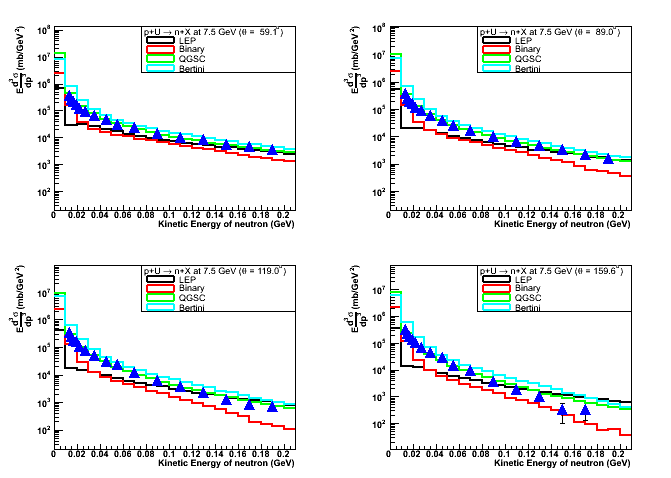Study performed by: Sunanda Banerjee, Julia Yarba (Fermilab)
- Data references: Yu.D. Bayukov et al., Preprint ITEP-148-1983;
Yu.D. Bayukov et al., Angular Dependences Of Inclusive Nucleon Production In Nuclear Reactions At High-Energies And Separation Of Contributions From Quasifree And Deep Inelastic Nuclear Processes, Sov.J.Nucl.Phys.42:116-121,1985;
HEPDATA
Simulation Conditions
- Geant4 version: 9.0.p01, 9.1.p01
- Models: LEP, Bertini, Binary, FTFP, QGSP, QGSC
Results
- Measured and simulated inclusive proton or neutron production in proton-A or pion-A interactions.
We have performed extensive studies using Geant4.9.0.p01. Detailed results can be found in the dedicated write-up.
Here we present several signatures plots from the Geant4.9.0.p01 round of study, i.e. measured and simulated inclusive proton production in proton-Cu and proton-Pb interactions as a function of beam energy.
Plots in Fig.1 are for proton-Be interactions; results are presented in 2 different kinetic energy bins (100MeV or 200MeV, left hand side plots) and for two different angles (59.1 degree, top row plot, or 119.0 degree, botton row plots) of the final state proton. Similar plots in Fig.2 and Fig.3 are for proton-Cu and proton-Pb interactions, respectively.
The black triangles in the plots represent experimental data, and the color-coded lines stand for different Geant4 physics models, as indicated in the box in the upper corner of each plot.
From these earlier studies we have found that, for a majority of beam energies, of kinetic energies of the final state particles, and for production into forward or backward hemisphere, predicions of the theory-driven Bertini cascade model are closer to the experimental data than predictions of all other models, for lighter targets "up to Cu", in the intermediate energy range. The Bertini's predicitions are also in reasonable agreement with the experimental data for neutron production by proton beam incident on heavier Pb target.
For modeling proton production by proton incident at heavier Pb target it is the LEP model's predicions that are closer to the experimental data.
In some cases, for lighter targets, predictions by QGSC model are in reasonable agreement with the experimental data. However, in many cases QGSC is far off.
Predictions by QGSP and FTFP models are inconsistent with the experiemntal data in all cases in this study.
It must also be noted that of all models LEP is the most economical in terms of CPU. Bertini, QGSP, and FTFP are a factor of 1.5-2 slower. QGSC is at least an order of magnitued more expensive in terms of CPU. - We have repeated the study with Gean4.9.1.p01. We have added to the study the data on inclusive proton and neutron production in pion-U or proton-U interactions, to compliment earlier studies for a heavy Pb target.
We have also extended comparisons vs experimental data on inclusive neutron production in pion-A or proton-A interactions. It must be pointed out that experimental data on the inclusive neutron production by a pion beam of all energies and by proton beam of low energy (1.4GeV) are only available for backward hemisphere (119.0 degree).
QGSP and FTFP have been excluded from from the tests, since in earlier round we have found that these models do not reproduce experimental data very well. Instead, we have added Binary cascades model to the study.
- Comparison of the simulation results from LEP, Bertini, Binary, and QGSC models vs experimental data are shown in Figures 4-26. The cross-sections are shown as a function of kinetic energy of the final state particle, at 4 different angles of the final state particle (production into forward or backward hemisphere) for each type of beam-target configuration.
- Figures 4-11 illustrate inclusive proton and neutron production by 1.4GeV pion incident on C, Cu, Pb or U target, respectively. Figures 12-18 show similar results results for 1.4GeV interacting with the same targets; unfortunately, no reliable data are available for inclusive neutron production for 1.4GeV proton-C case.
Figures 19-26 show inclusive proton or neutron production by 5.0GeV pion beam incident on C, Cu, Pb, or U target.
Figures 27-34 illustrate inclusive proton and neutron production in the 7.5GeV proton-A interactions. - As we observe, at low energy predictions by Binaray cascade model provides best agreement with the data for inclusive proton production, by either pion or proton beam, on all targets. LEP and QGSC are inconsistent when modeling inclusive proton yield, as their predictions may either sharly fall or jump way above the data.
Discrepancies are less striking in simulation of inclusive neutron production, especially on lighter targets. On heavier targets LEP tends to overestimates the neutron cross-sections, and QGSC underestimates; difference are more obvious in the backward hemisphere. Predicions of Bertini and Binary cascades models are still close to each other, and to the data, when available. - As we move to 5GeV pion, the Binary cascades model consistently underestimates both proton and neutron yield, on all targets.
LEP and QGSC tend to overestimate the cross-sections on lighter targets (C, Cu).
On heavier targets (Pb, U) predictions of Bertini, LEP, and QGSC are closer to each other, with LEP probably been the best match to the data (except some descripancies in the very backward production).
- Inclusive forward proton and neutron production by 7.5GeV proton beam on the light C target is reasonably well modeled by either Bertini or Binary cascades model, while none of the models in test provide good description of backward production of either final state particle.
For heavier targets (Cu and onward), Binary cascades show the same tendency (underestimate) as we observed when modeling pion-A interactions.
Bertini and QGSC tend to overestimate proton and neutron production of heavy (Pb, U) targets, while LEP is models the data reasonably well (with slight tendency to underestimate) - As far as speed of the code is concerned, we know from earlier rounds that, of all models, LEP is the most economical in terms of CPU. Bertini, QGSP, and FTFP are a factor of 1.5-2 slower. QGSC is at least an order of magnitued more expensive in terms of CPU Here it must also be added that Binary cascades tend to consume CPU comparable to that needed by QGCS and considerably larger than LEP or Bertini, especially for heavier targets.
- Overall, this study confirms our findings in earlier rounds:
- Bertini model represents the experimental data reasonably well in more cases than any other models.
- LEP provides reasonable description for heavy targets, except for low (1.4GeV) beam energy, and is also attractive as most economical in terms of CPU.
- Binary cascade model is reasonably good for low-energy cases. But it systematically underestimates the cross-sections as the beam energy increases. It's also quite espensive in terms of CPU, especially for modeling interactions of headrons with heavy targets.
- QGSC gives reasonable results for heavier tagets, but is inconsistent at low beam enegies. It's also at least an order of mannitude slower than any other model.
- There're cases where NO model is good enough.
Plots:
Black (Fig.1-3) or brlue (Fig.4-26) triangles are for experimantal data, color-coded lines are for Geant4 hadronic interaction modelsFigures 1-3 are have been produced with Geant4.9.0.p01.
- Figure 1: differential cross-section of the inclusive proton production in proton-Be interactions as a function of beam energy, in 2 kinetic energy bins and for 2 different angles of the final state proton.
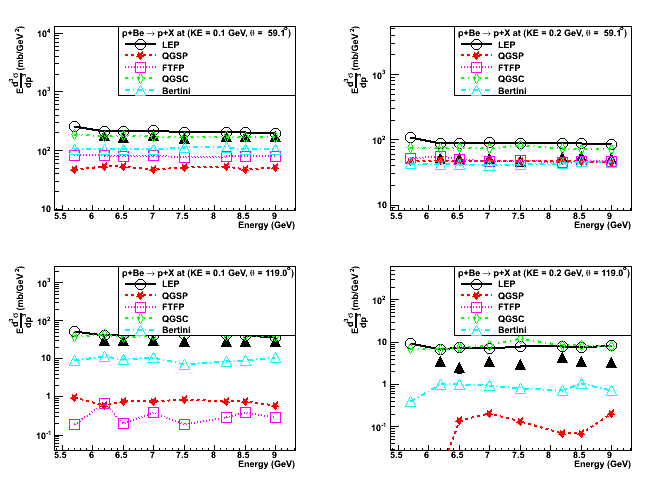
- Figure 2: differential cross-section of the inclusive proton production in proton-Cu interactions as a function of beam energy, in 2 kinetic energy bins and for 2 different angles of the final state proton.
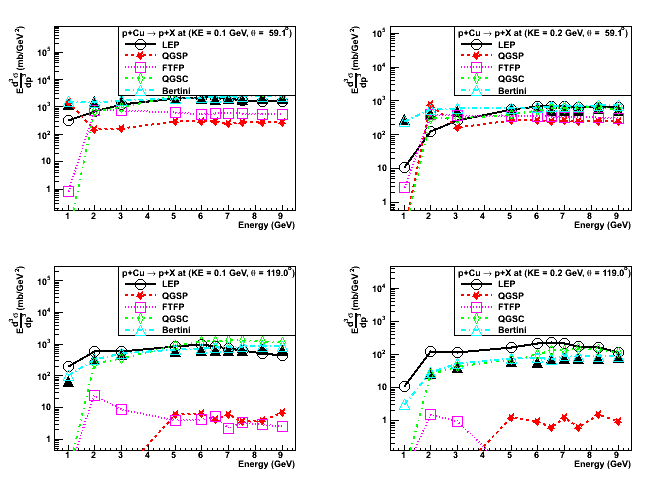
- Figure 3: differential cross-section of the inclusive proton production in proton-Pb interactions as a function of beam energy, in 2 kinetic energy bins and for 2 different angles of the final state proton.
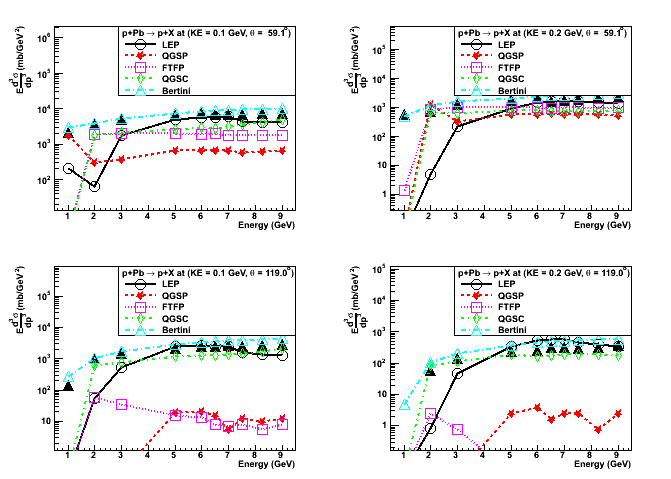
- Figure 4: 1.4GeV pi+ on C target - inclusive proton yield as a function of kinetic energy, at different angles of the final state particle.
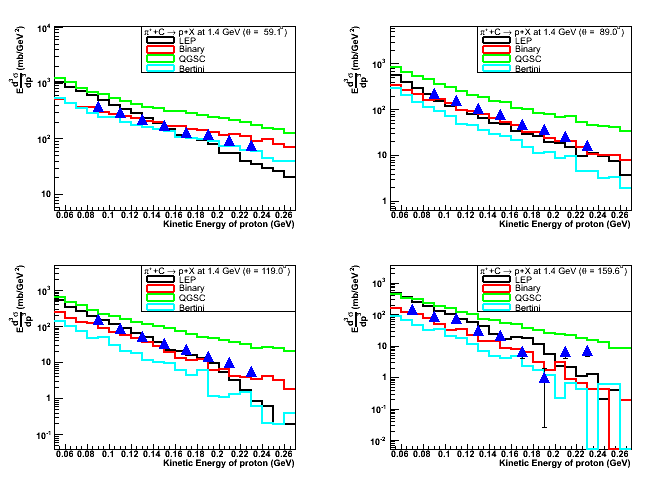
- Figure 5: 1.4GeV pi+ on C target - inclusive neutron yield as a function of kinetic energy, at different angles of the final state particle.
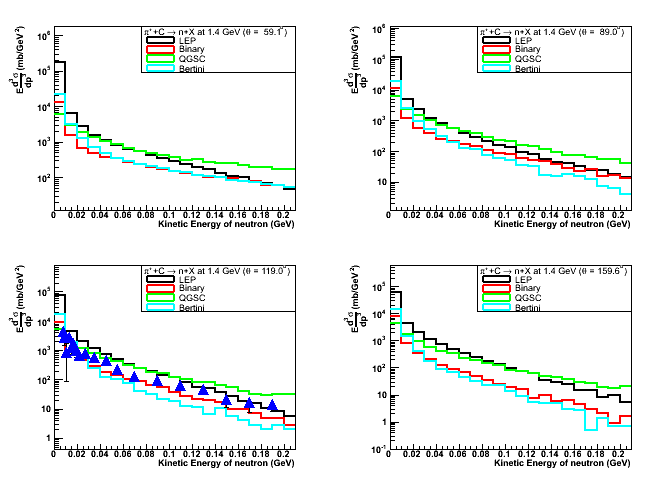
- Figure 6: 1.4GeV pi+ on Cu target - inclusive proton yield as a function of kinetic energy, at different angles of the final state particle.
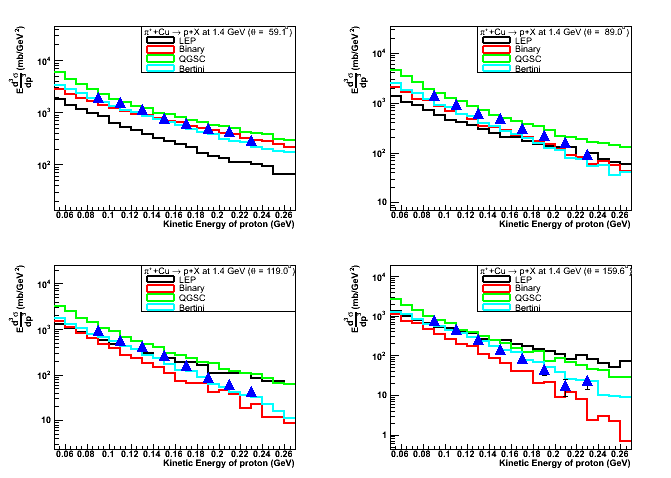
- Figure 5: 1.4GeV pi+ on Cu target - inclusive neutron yield as a function of kinetic energy, at different angles of the final state particle.
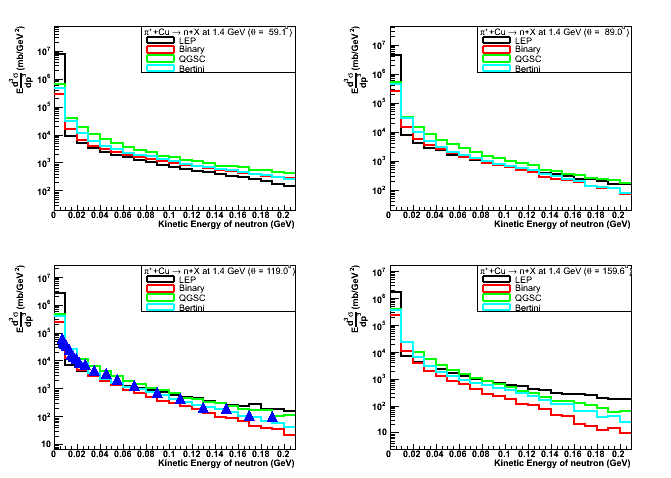
- Figure 8: 1.4GeV pi+ on Pb target - inclusive proton yield as a function of kinetic energy, at different angles of the final state particle.
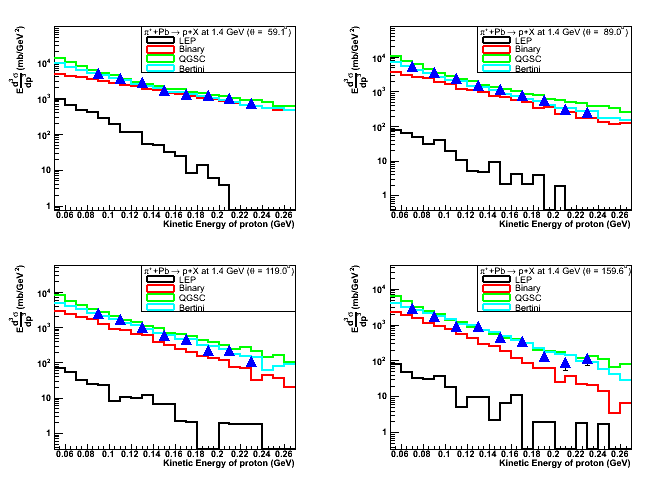
- Figure 9: 1.4GeV pi+ on Pb target - inclusive neutron yield as a function of kinetic energy, at different angles of the final state particle.
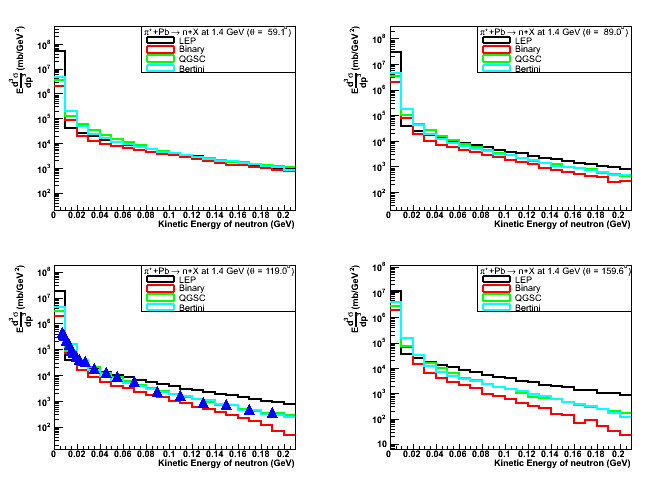
- Figure 10: 1.4GeV pi+ on U target - inclusive proton yield as a function of kinetic energy, at different angles of the final state particle.
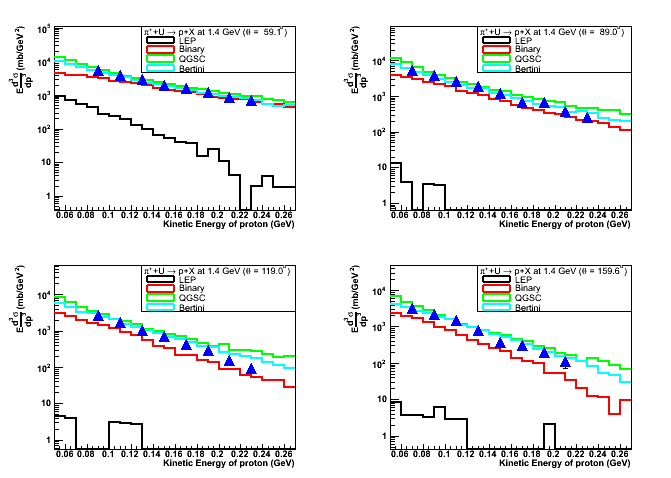
- Figure 11: 1.4GeV pi+ on U target - inclusive neutron yield as a function of kinetic energy, at different angles of the final state particle.
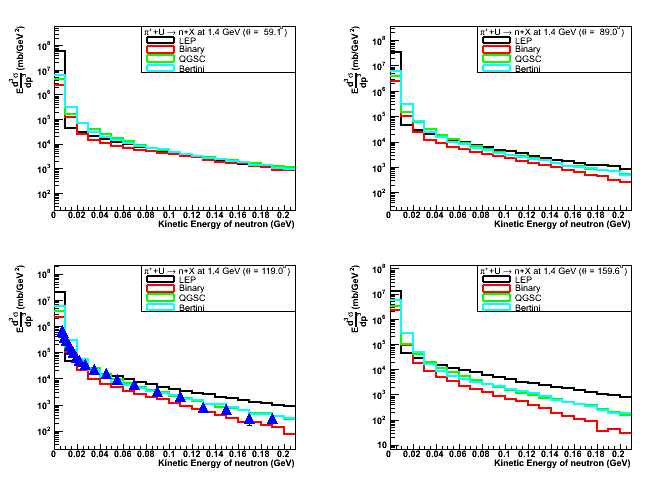
- Figure 12: 1.4GeV proton on C target - inclusive proton yield as a function of kinetic energy, at different angles of the final state particle.
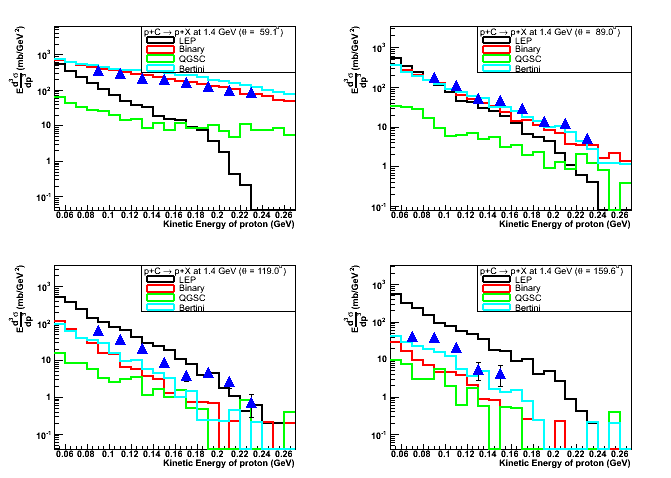
- Figure 13: 1.4GeV proton on Cu target - inclusive proton yield as a function of kinetic energy, at different angles of the final state particle.
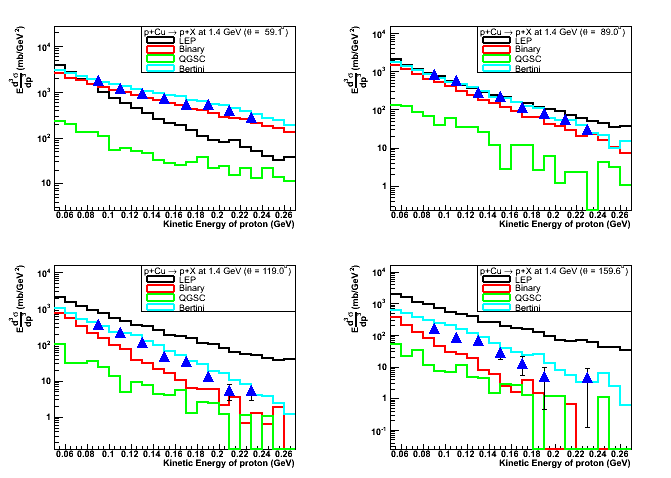
- Figure 14: 1.4GeV proton on Cu target - inclusive neutron yield as a function of kinetic energy, at different angles of the final state particle.
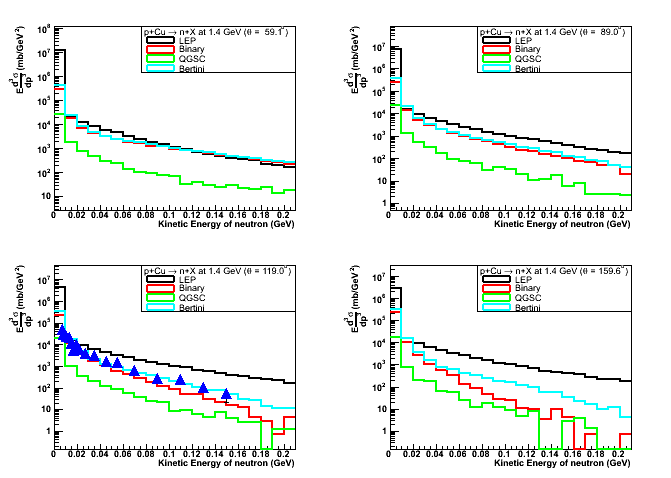
- Figure 15: 1.4GeV proton on Pb target - inclusive proton yield as a function of kinetic energy, at different angles of the final state particle.
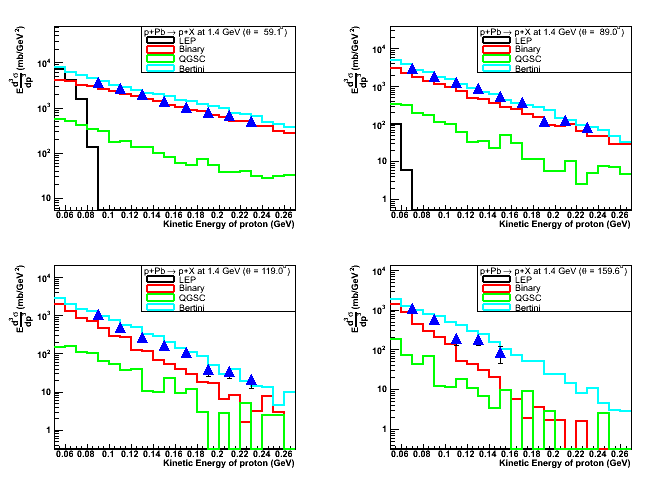
- Figure 16: 1.4GeV proton on Pb target - inclusive neutron yield as a function of kinetic energy, at different angles of the final state particle.
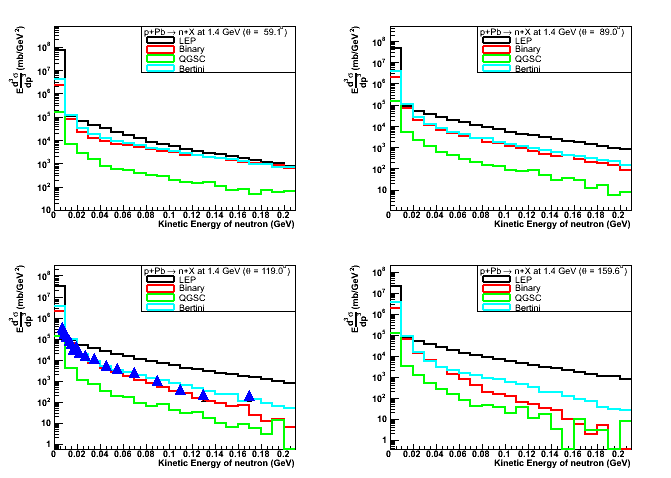
- Figure 17: 1.4GeV proton on U target - inclusive proton yield as a function of kinetic energy, at different angles of the final state particle.
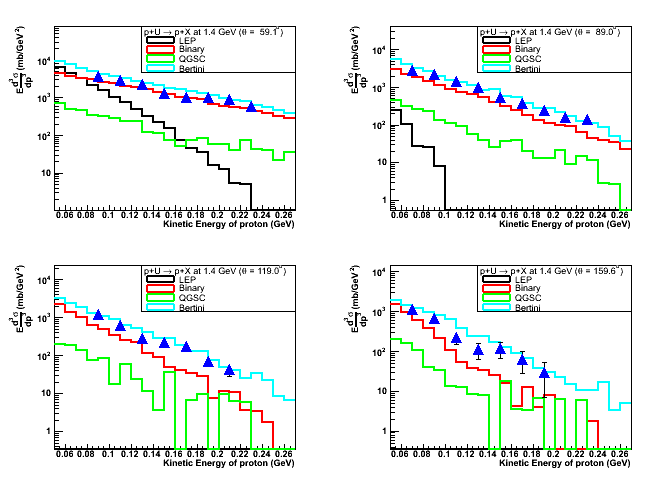
- Figure 18: 1.4GeV proton on C target - inclusive neutron yield as a function of kinetic energy, at different angles of the final state particle.
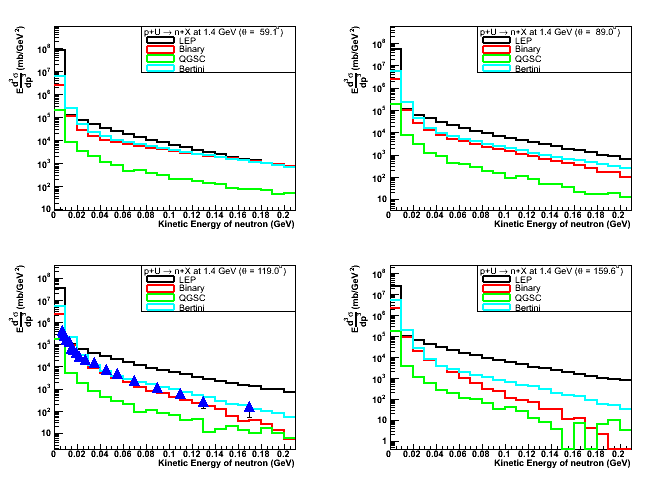
- Figure 19: 5.0GeV pi+ on C target - inclusive proton yield as a function of kinetic energy, at different angles of the final state particle.

- Figure 20: 5.0GeV pi+ on C target - inclusive neutron yield as a function of kinetic energy, at different angles of the final state particle.
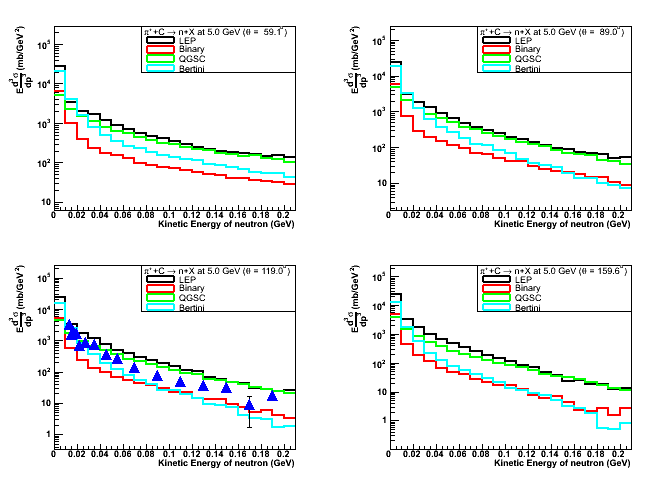
- Figure 21: 5.0GeV pi+ on Cu target - inclusive proton yield as a function of kinetic energy, at different angles of the final state particle.
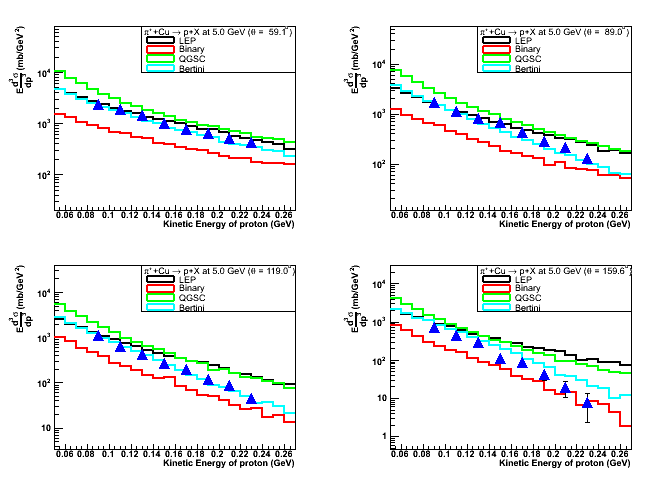
- Figure 22: 5.0GeV pi+ on Cu target - inclusive neutron yield as a function of kinetic energy, at different angles of the final state particle.
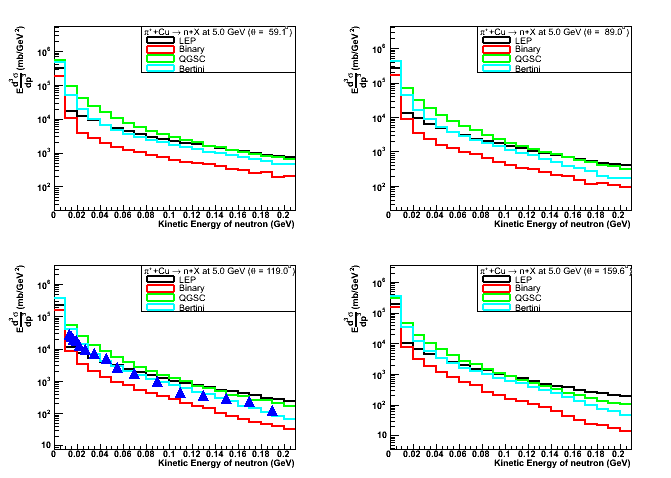
- Figure 23: 5.0GeV pi+ on Pb target - inclusive proton yield as a function of kinetic energy, at different angles of the final state particle.
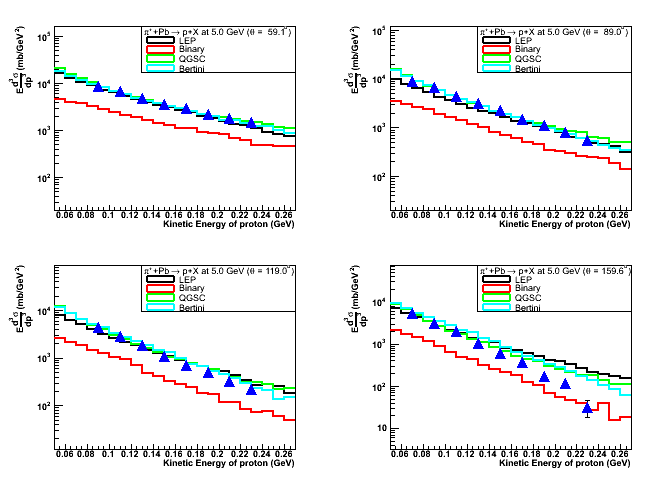
- Figure 24: 5.0GeV pi+ on Pb target - inclusive neutron yield as a function of kinetic energy, at different angles of the final state particle.
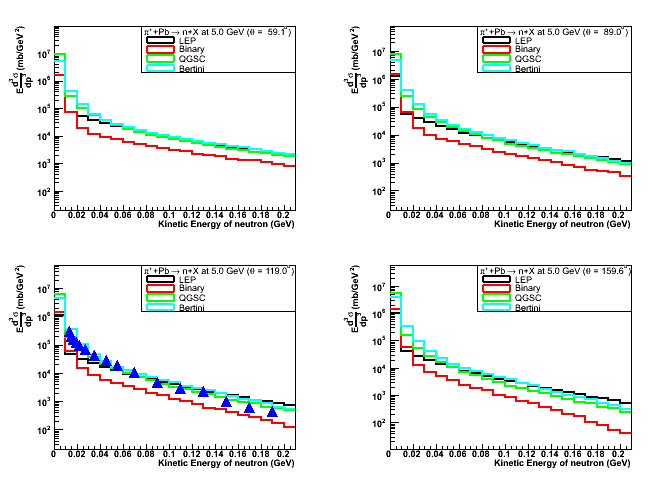
- Figure 25: 5.0GeV pi+ on U target - inclusive proton yield as a function of kinetic energy, at different angles of the final state particle.

- Figure 26: 5.0GeV pi+ on U target - inclusive neutron yield as a function of kinetic energy, at different angles of the final state particle.
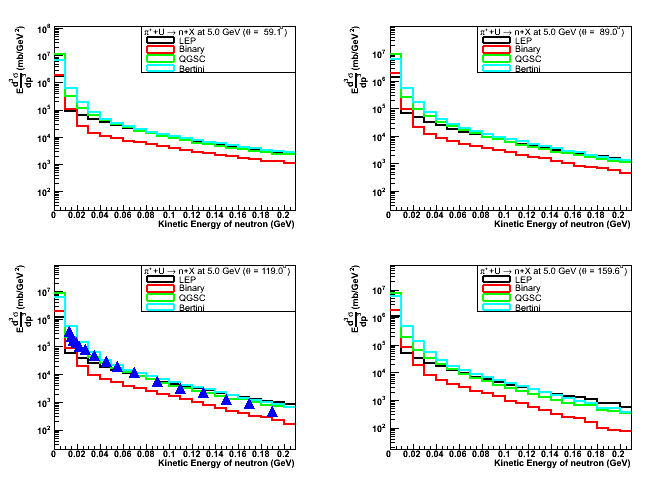
- Figure 27: 7.5GeV proton on C target - inclusive proton yield as a function of kinetic energy, at different angles of the final state particle.
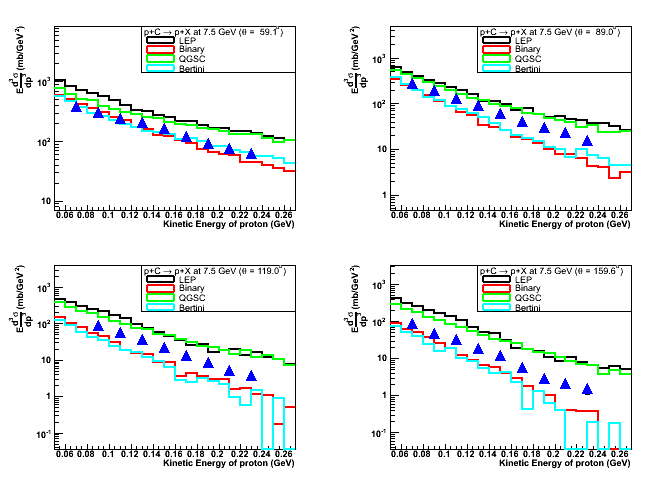
- Figure 28: 7.5GeV proton on C target - inclusive neutron yield as a function of kinetic energy, at different angles of the final state particle.
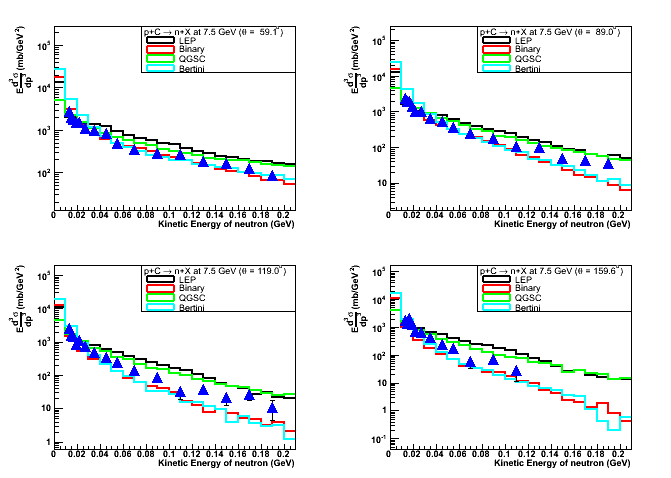
- Figure 29: 7.5GeV proton on Cu target - inclusive proton yield as a function of kinetic energy, at different angles of the final state particle.
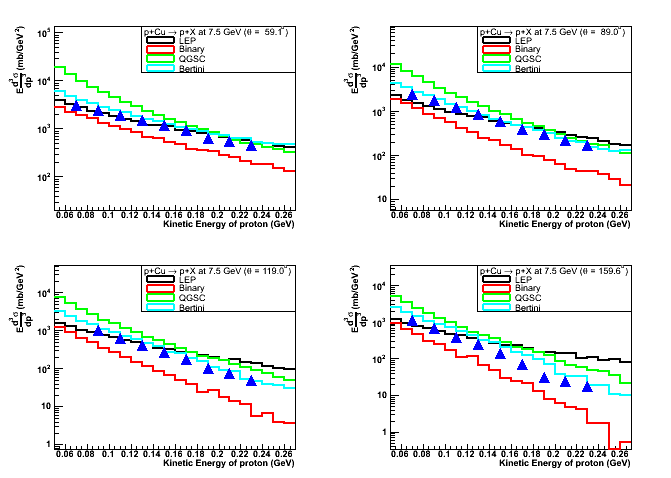
- Figure 30: 7.5GeV proton on Cu target - inclusive neutron yield as a function of kinetic energy, at different angles of the final state particle.
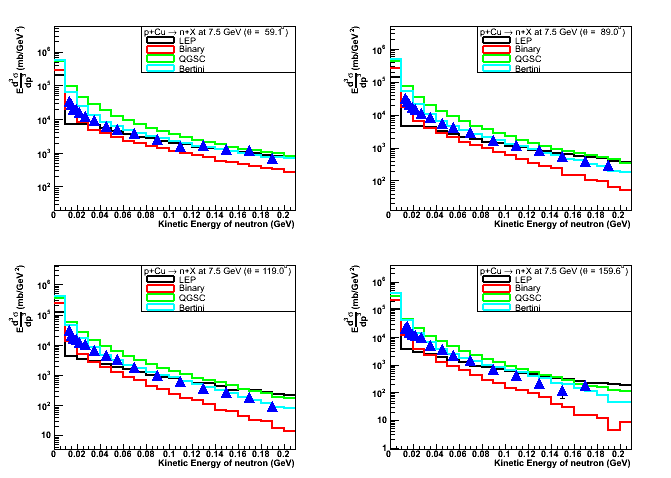
- Figure 31: 7.5GeV proton on Pb target - inclusive proton yield as a function of kinetic energy, at different angles of the final state particle.
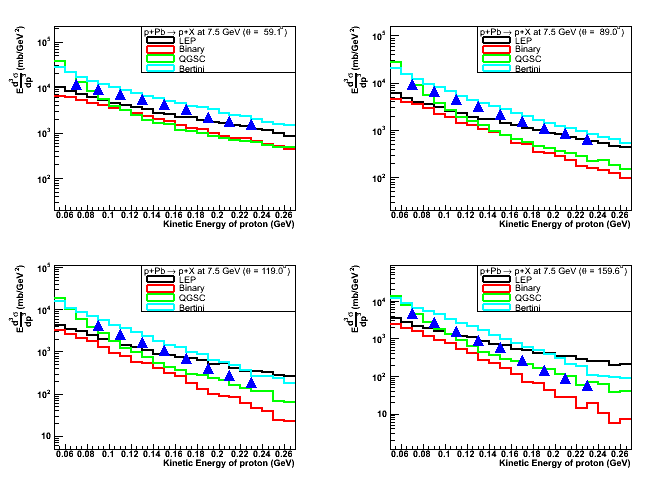
- Figure 32: 7.5GeV proton on Pb target - inclusive neutron yield as a function of kinetic energy, at different angles of the final state particle.
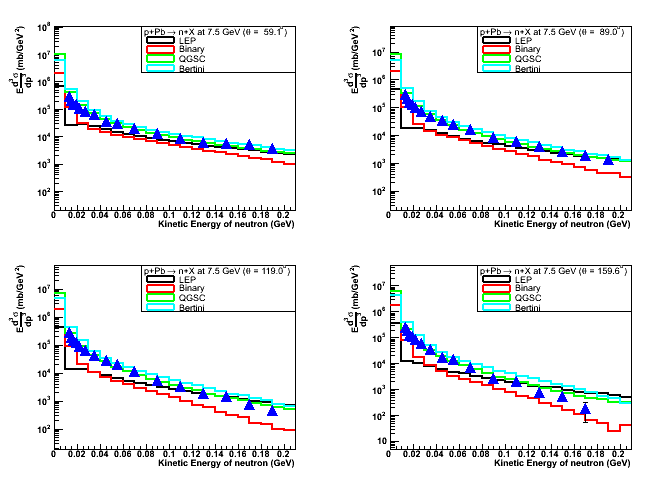
- Figure 33: 7.5GeV proton on U target - inclusive proton yield as a function of kinetic energy, at different angles of the final state particle.
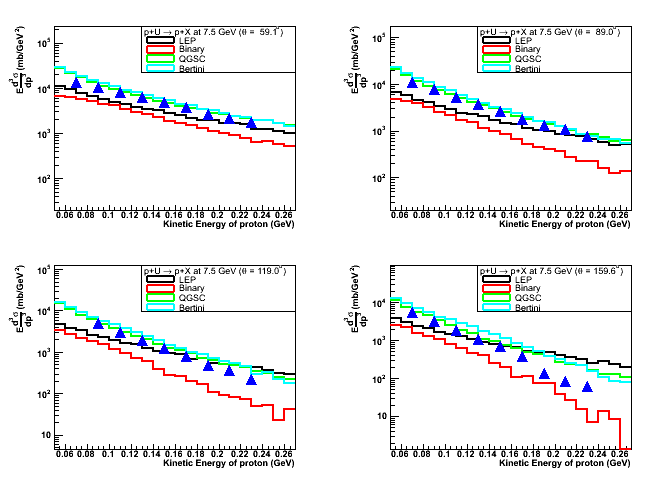
- Figure 34: 7.5GeV proton on U target - inclusive neutron yield as a function of kinetic energy, at different angles of the final state particle.
